7 Reasons We’re Going To Miss Jeff Lemire’s Animal Man
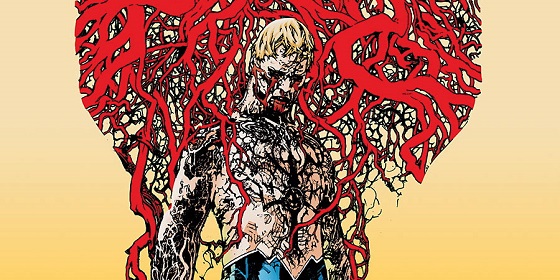 |
Today, DC’s Animal Man comes to an end with issue #29. One of many titles included in the company’s New 52 relaunch, it was a surprise critical success, as well as a minor commercial hit for a while. Written by Canadian Jeff Lemire of Essex County and Sweet Tooth fame and illustrated primarily by Travel Foreman and Steve Pugh, it told the story of Buddy Baker, a former Hollywood stuntman who gained the ability to adopt certain animal traits – e.g. the speed of a cheetah, the flight of an albatross, the ferocity of a lion – whenever the need arose. Lemire is moving on to greener, or at least more northern, pastures with Justice League Canada (now titled Justice League United), but as we wait for issue #0 to hit stands next month let’s bid a fond farewell to one of DC’s most interesting, unconventional and downright excellent titles. Animal Man was something else, and that something else wasn’t afraid to scare or gross the hell out of us every other issue.
Here’s why we’ll miss it…
7. It Wasn’t Really a Superhero Comic
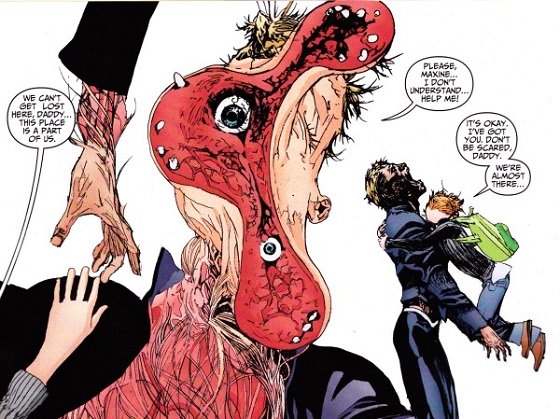 |
| Travel Foreman |
Though writer Dave Wood and artist Carmine Infantino conceived of Animal Man as a superhero, both Lemire and Morrison pretty much ignored that aspect for their respective runs on the series. Yeah, they still had Buddy fight crime and do awesome shit with his powers, such as using sheer strength to rip a goddamn wolf in half, but neither writer was interested in going the usual route of conventional superhero titles like Batman or Superman. Morrison’s run, for instance, started out as a superhero series with a vegetarian and environmentalist angle, but by his final issue he had shattered the fourth wall and burnt its remnants to a crisp by having Buddy converse with an illustrated manifestation of the writer about fiction and current trends in comics.
Lemire’s series, on the other hand, was straight-up, balls-out horror. By the end of the first issue, Buddy was dreaming of finding his son eviscerated – ensuring the series’ “T” rating from the get-go – and encountering a trio of spectral beasts that looked like a Body Worlds exhibit by way of David Cronenberg (actually, many of the creature designs and Lemire’s use of body horror is like something the Torontonian director would come up with if he actually liked superheroes). Whether for the main series or for the Rotworld crossover with Scott Snyder’s Swamp Thing, Lemire and his crew weren’t afraid to push the boundaries of what could be shown in mainstream (i.e. non-Vertigo or -Max) comics. Their results helped Animal Man stand out from the dozens of similar superhero titles on the racks and, oh goodness, hippos shouldn’t do that, oh no.
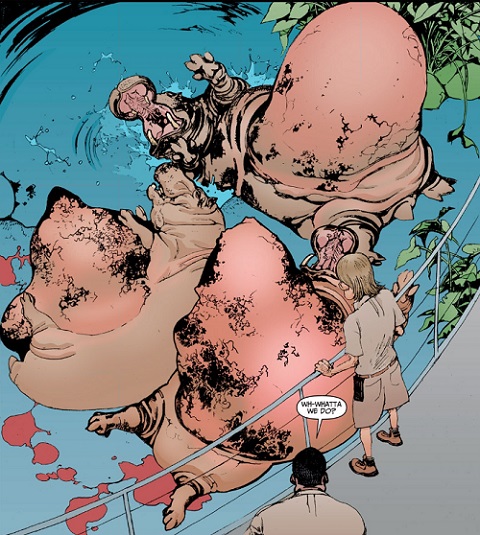 |
| Travel Foreman |
6. It Knew Its Place
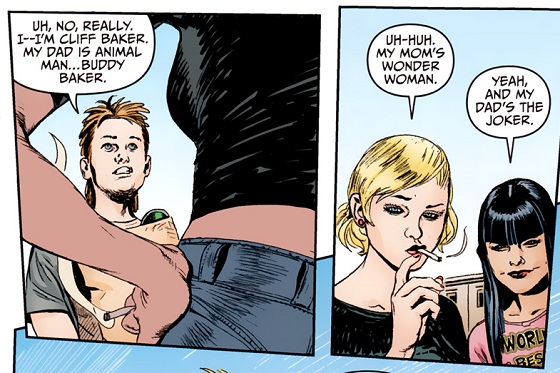 |
| Steve Pugh |
Gather up a bunch of comic-book fans and it’s likely only a small percentage of them have ever heard of Animal Man. He’s a C-lister, the Billy Zane of DC Comics (except he never had something as big as Titanic under his belt), and it’s shocking to see the character have his own title when, in terms of popularity, he’s on the same level as Booster Gold or Blue Beetle. But Lemire didn’t approach the series with his head in the clouds saying “I am going to make Animal Man the coolest and most awesome superhero ever just you wait.” From start to finish, he gave the character a tongue-in-cheek modesty. He’s not the most important guy in the world, and he knows it, but he’ll don the suit and help out when needed – provided he has the evening off.
By comparison, Geoff Johns went the exact opposite direction with the New 52 take on Aquaman who, despite his posturing and new “badass” angle, just comes off as overcompensating for an inferiority complex. As Chris Sims of ComicsAlliance points out, it reads less like a genuine attempt at making the character cool and more like an ardent Aquaman fanboy ranting breathlessly on a message board about how important the character is can’t you guys see?!? Buddy Baker, however, takes his unpopularity in stride, and even embraces it. While Aquaman might be washing his El Camino while shirtless in full view of the neighbours, Buddy’s just a cool dad.
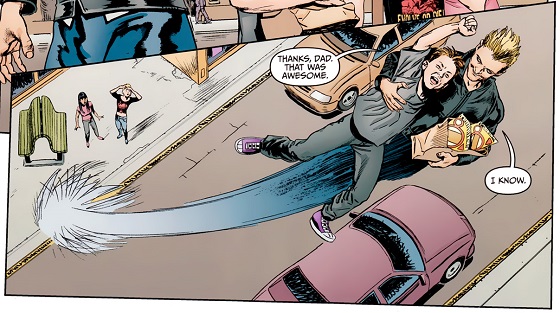 |
| Steve Pugh |
5. The Art Was Fantastic
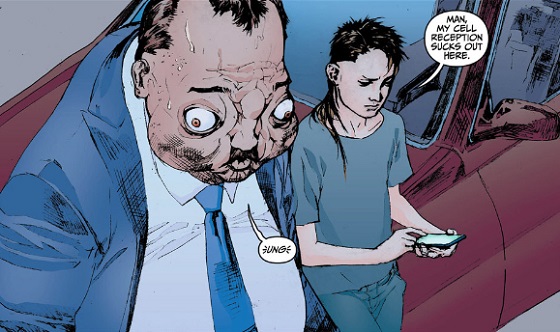 |
| Travel Foreman |
While Travel Foreman was the primary artist for only the first eight issues of Animal Man, it can’t be overstated how essential he was to establishing the tone and look of that comic. His thin line work and detailed shading straddled the line between the realistic and the disturbingly uncanny. Moreover, his style highlighted the fact that this wasn’t your average superhero book. Other artists have included Steve Pugh – who also illustrated Jamie Delano’s run on the series in the 1990s – and Raphael Albuquerque of American Vampire fame, both of whom have styles that best served the off-kilter nature of the title.
And as if you didn’t already have a reason to anticipate the final issue, Lemire is illustrating the bulk of #29 in his distinctive, emaciated style. And with the amount of hybrid animal totems seen in this series, there’s no better time to sneak in Sweet Tooth‘s Gus.
4. Its Mythology Was Actually Pretty Cool
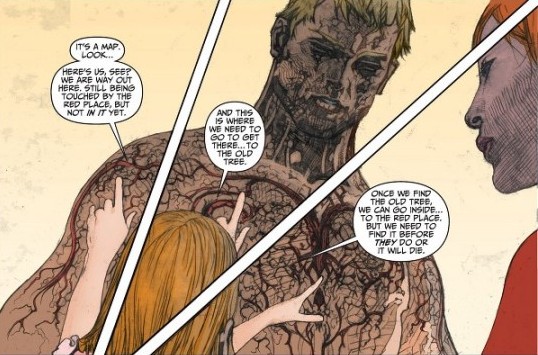 |
| Travel Foreman |
In this corner of the DC Universe, awkwardly labeled the “Dark” series of titles, we learn that the basic elements of life are the “Green” (flora), the “Red” (fauna) and the “Rot” (death), all three of which are constantly in battle and threatening to upset a universal equilibrium. All three are portrayed as necessary elements for existence, with the Rot’s crimes later on in the series not due to it being inherently “evil” but because it’s knocked things out of whack.
While admittedly pretty fantastical, this goes a long way to string together some previously not-very-cohesive parts of the DC Universe, such as Swamp Thing, Anton Arcane and even Medphyll, that one Green Lantern who’s also a sentient tree. The end result is a fleshed-out mythology that DC can pick up on, use and – knowing them – mess up at a later date.
3. It Had A Genuinely Great Crossover
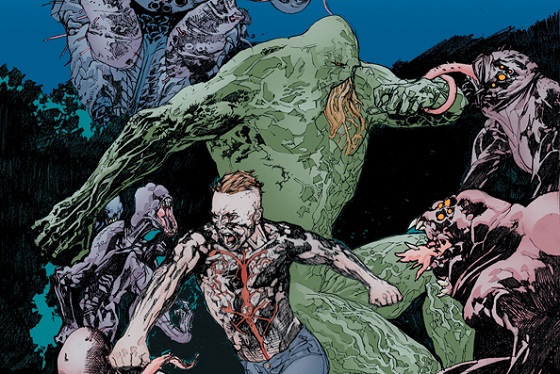 |
| Travel Foreman |
Pretty much any modern crossover, be it Darkest Night or Siege or Flashpoint, suffers from almost exponential escalation where by the end the stakes are so high and the action is so huge that you can’t really relate to them anymore – Dragonball Z Syndrome, for lack of a better term. The Rotworld crossover, co-written by Lemire and Scott Snyder, goes to some pretty extreme lengths, focusing on Animal Man and Swamp Thing’s attempt to undo an alternate timeline where the Rot has taken over the world and turned everyone from Superman to Batman into Cronenbergian monstrosities.
As the two eventually set things right and restore the original, untainted timeline, it appears as though Rotworld is just as disposable an event comic as any other. But through it, Lemire and Snyder created a situation in which these two actually were important to the DC Universe at large; just not in the chosen one/linchpin/Kwisatz Haderach sense that permeates almost all superhero stuff, but by establishing that everyone in that world, big or small, has a part to play of some kind. That might sound like hippie nonsense to some, but it’s a much-needed humbling element for a fictional world populated by literal gods.
2. It Was Actually About People
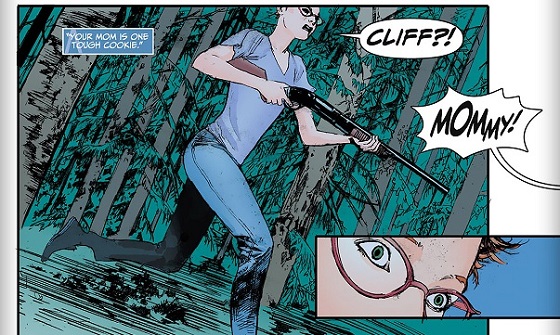 |
| Travel Foreman |
You’ll notice that for most of this list, Animal Man has frequently been referred to by his legal name rather than his superheroic identity. It’s not because “Animal Man” sounds dumb or gimmicky; if that were true we would also have to be ashamed to say “Batman,” “Superman” or “Wonder Woman” out loud. It’s because more than anything else, Lemire succeeded at making this superhero and his supporting cast feel like actual human beings – superpowered human beings, in a couple cases, but human beings nonetheless. It’s about a dad realizing one of his children will do greater things than he could ever hope to aspire to; it’s about a brother envying his sister for powers he’ll never have; it’s about a mother torn between her love for her husband and her desire to keep her kids safe at all cost. Most of all, it’s about a family in way over their heads, pursued by forces that might unnerve even Superman, and doing their best to keep each other alive.
All superheroes have loved ones to keep them grounded: Superman has Lois Lane, Spider-Man has Mary Jane, the Punisher has – well, had – a family. But when those supporting characters are in danger, it’s primarily to add tension to the plot and give those heroes something to fight for. With Animal Man, Lemire developed the Bakers so well that when one of them is in danger, it isn’t a promotional stunt: it’s the very core of the series. Reading his more realistic, family-centric works like Essex County and The Underwater Welder, it’s not surprising that he brought that element of intimacy to Animal Man, but it is something relatively unheard of in the realm of mainstream superhero comics. And without his human touch, we probably wouldn’t have moments like this.
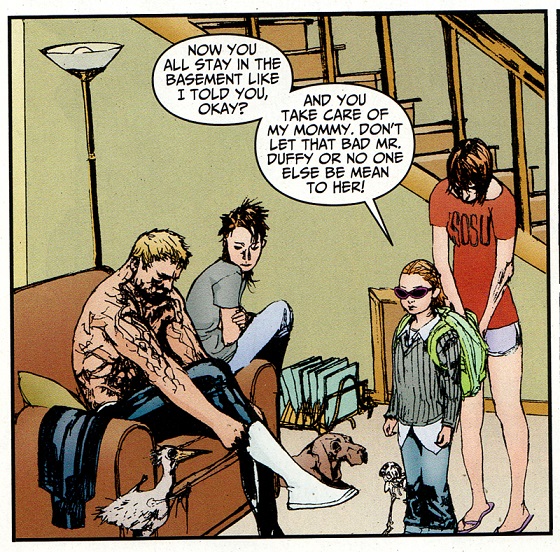 |
| Travel Foreman |
1. Socks the Cat
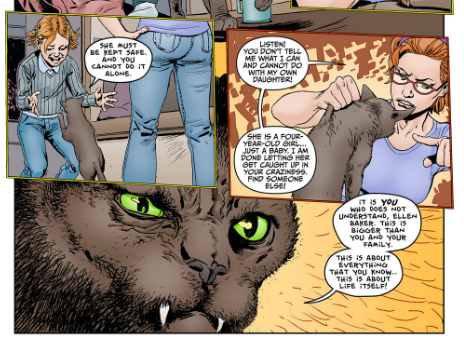 |
Look, the Lying Cat from Saga is cool and all, but she ain’t got nothin’ on Totem of the Red-turned-housecat Socks. Not since the little Arquillian dude from Men in Black has a character shorter than two feet high carried on with so much gravitas.
